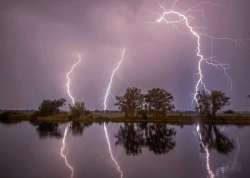Odisha registers 31 per cent decline in number of lightning deaths
While 465 lightning deaths were recorded in Odisha during the year 2017-18, it came down to 320 in 2018-19 which is about 31 per cent decline in rate of human casualty, said Special Relief Commissioner (SRC) B P Sethi.

Odisha has registered a decline in human casualty due to lightning by 31 per cent during 2018-19 following effective use of Early Warning Communication system (EWCS), a senior official said.
While 465 lightning deaths were recorded in Odisha during the year 2017-18, it came down to 320 in 2018-19 which is about 31 per cent decline in rate of human casualty, said Special Relief Commissioner (SRC) B P Sethi.
The SRC said 401 people died due to lightning in the year 2015-2016 and in 2016-17 the figure was 400, the SRC said.
Asked about the reason behind the decline in lightning deaths, Sethi said the office of the SRC and Odisha Disaster State Disaster Management Authority (OSDMA) has taken a number of steps to arrest the increasing trend of lightning deaths in the state.
The campaign includes making people aware about the lightning hazard and the safety measures for saving lives from such incidents.
A MoU have been signed between the Special Relief Commissioner-cum-Managing Director, OSDMA on behalf of the Odisha government and the Earth Networks of the USA to get the advance information about the upcoming lightning with a view to alerting the citizens to enable them to take the required precautionary measures for saving their lives.
The Earth Networks has set up six lightning sensors across Odisha and is providing information on a regular basis to OSDMA about probable lightning incidents, 30-40 minutes in advance, along with the map briefly showing the area where lightning is likely to strike, he pointed out.
The information with map thus received from Earth Networks is quickly processed on GIS platform in OSDMA and the geographic coordinates of the probable area of lightning strike is communicated to the state emergency operations centre for sending SMS alerts to the people of that area through Location Based Alert System (LBAS).
The SMS alerts are sent through LBAS to the people who are present in the area likely to be affected by the lightning strike.
"The entire operations from receipt of the information from earth networks till despatch of the SMSes are completed in 2-3 minutes. The state emergency operations centre is functioning in the office of the Special Relief Commissioner," Sethi said.
OSDMA has also collaborated with the Regional Integrated Multi-Hazard Early Warning System for Africa and Asia (RIMES), Thailand for developing an integrated Decision Support System (DSS) for providing real time watch, alert, and warning information for different hazards like heat wave, lightning, droughts, ocean state information and floods.
Meanwhile, the OSDMA has developed an application "SATARK" (System for Accessing, Tracking and Alerting Disaster Risk Information Based on Dynamic Risk Knowledge). The citizens are downloading this app and using the same to get early alerts about lightning incidents, he said.
Apart from the above, an intelligent and automated system known as 'Outdoor Alerting System' has been installed in 14 most lightning vulnerable blocks of the state for quickly disseminating the warning to citizens.
The siren installed in this system will automatically blow before approach of any lightning and severe weather, which will be audible to the people in the vicinity. People getting such siren alerts may inform others through different modes. The system will be expanded in future, Sethi said.
Official sources said about 85 per cent of total deaths due to lightning occur during the months of May to September.
Also Read | Odisha Chief Minister Naveen Patnaik seeks direct flight between Bhubaneswar-Dubai
Also Read | Commission submits 7th interim report on Odisha chit fund scam